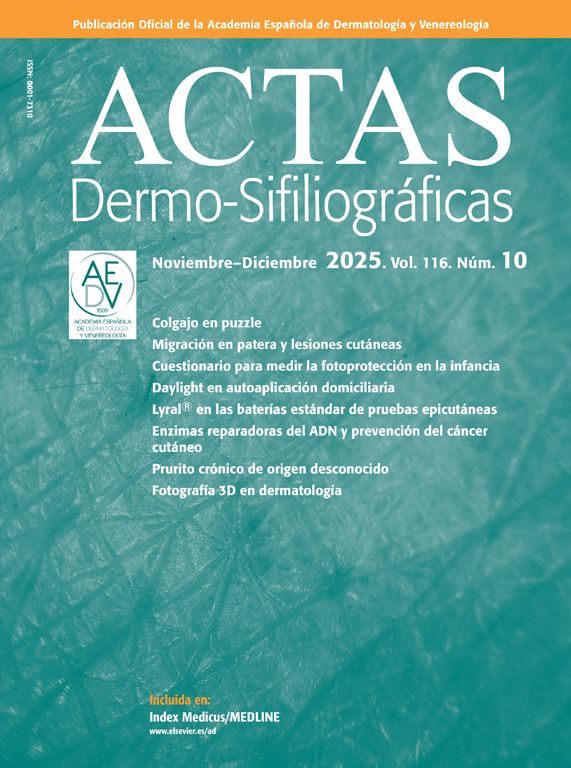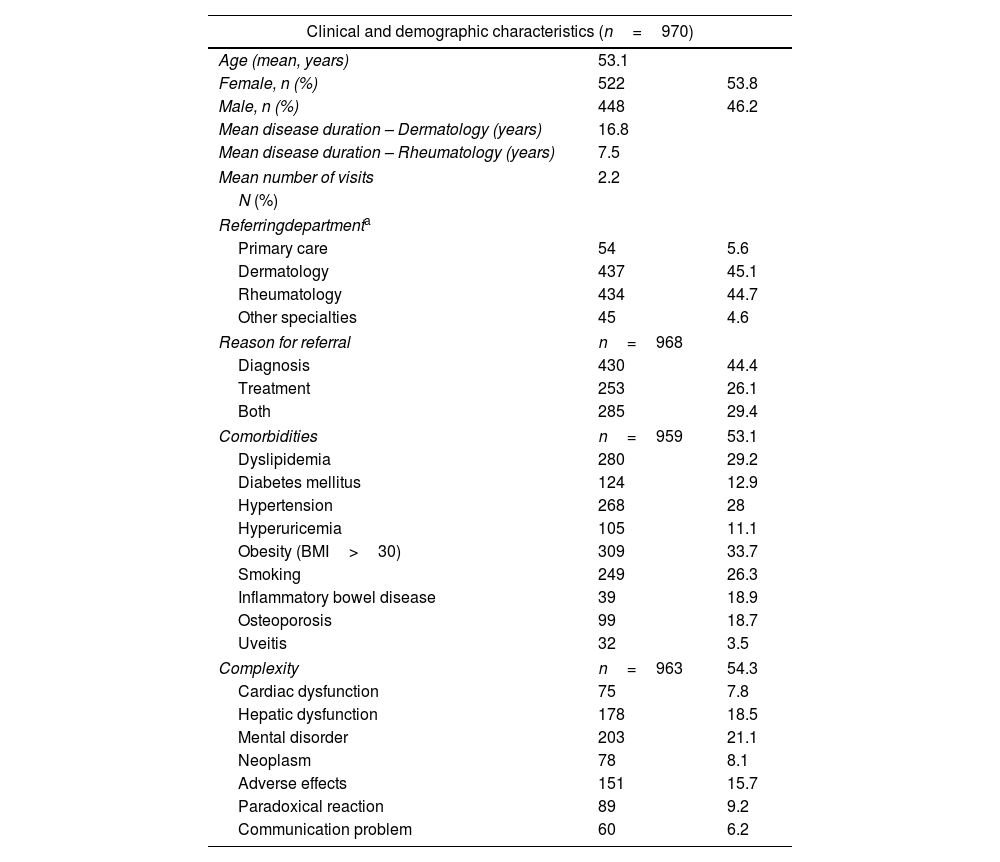Joint management of psoriatic arthritis (PsA) can be very effective in some patients, although there is limited evidence in the literature based on large series of clinical data.1–9
The aim of this article is to quantify the diagnostic and therapeutic changes experienced by patients due to their passage through the PAIDER clinic (Comprehensive Care Program for Dermatology and Rheumatology Patients) of a tertiary referral center specializing in the management of immunomediated diseases from June 29th, 2012 to July 4th, 2023. This study was approved by the center ethics committee. An episode was defined as the set of visits made by a patient until discharge. A complex patient was defined as one who exhibited psychiatric, cardiac, hepatic, or oncological disease, communication problems, or treatment-related issues. Statistical analysis was performed using SPSS 28 statistical software.
The sample consists of 970 episodes generated from 732 patients who attended the clinic on different occasions over the years. A total of 53.8% of these were women, and the mean age was 53.1 years. Disease duration, origin, reasons for consultation detailed by referring services, comorbidities, and the proportion of complex patients are shown in Tables 1 and 2.
Clinical and demographic characteristics of patients and initial and final diagnoses in the PAIDER clinic.
| Clinical and demographic characteristics (n=970) | ||
|---|---|---|
| Age (mean, years) | 53.1 | |
| Female, n (%) | 522 | 53.8 |
| Male, n (%) | 448 | 46.2 |
| Mean disease duration – Dermatology (years) | 16.8 | |
| Mean disease duration – Rheumatology (years) | 7.5 | |
| Mean number of visits | 2.2 | |
| N (%) | ||
| Referringdepartmenta | ||
| Primary care | 54 | 5.6 |
| Dermatology | 437 | 45.1 |
| Rheumatology | 434 | 44.7 |
| Other specialties | 45 | 4.6 |
| Reason for referral | n=968 | |
| Diagnosis | 430 | 44.4 |
| Treatment | 253 | 26.1 |
| Both | 285 | 29.4 |
| Comorbidities | n=959 | 53.1 |
| Dyslipidemia | 280 | 29.2 |
| Diabetes mellitus | 124 | 12.9 |
| Hypertension | 268 | 28 |
| Hyperuricemia | 105 | 11.1 |
| Obesity (BMI>30) | 309 | 33.7 |
| Smoking | 249 | 26.3 |
| Inflammatory bowel disease | 39 | 18.9 |
| Osteoporosis | 99 | 18.7 |
| Uveitis | 32 | 3.5 |
| Complexity | n=963 | 54.3 |
| Cardiac dysfunction | 75 | 7.8 |
| Hepatic dysfunction | 178 | 18.5 |
| Mental disorder | 203 | 21.1 |
| Neoplasm | 78 | 8.1 |
| Adverse effects | 151 | 15.7 |
| Paradoxical reaction | 89 | 9.2 |
| Communication problem | 60 | 6.2 |
| Diagnosis, n (%) | Initial | Final |
|---|---|---|
| Peripheral PsA | 243 (25.7) | 413 (43.9) |
| Axial PsA | 45 (4.8) | 79 (8.4) |
| Mixed PsA | 93 (9.9) | 121 (12.9) |
| Rheumatoid arthritis | 24 (2.5) | 27 (2.9) |
| Ankylosing spondylitis | 48 (5.1) | 24 (2.5) |
| SAPHO | 11 (1.2) | 12 (1.3) |
| Hidradenitis suppurativa | 73 (0.3) | 7 (0.7) |
| Dactylitis/enthesitis/mono-oligoarticular arthritis | 99 (10.5) | 41 (4.3) |
| Psoriasis | 378 (40) | 217 (23.1) |
Reasons for consultation by referring service.
| Consultation for diagnosis, n (%) | Consultation for treatment, n (%) | Consultation for diagnosis and treatment, n (%) | |
|---|---|---|---|
| Primary care | 14 (25.9) | 11 (20.4) | 29 (53.7) |
| Dermatology | 220 (50.3) | 79 (18.1) | 138 (31.6) |
| Rheumatology | 191 (44.0) | 152 (35.0) | 91 (21.0) |
| Other hospital specialists | 5 (11.6) | 11 (25.5) | 27 (62.7) |
Data from 968 episodes.
The median number of visits per episode was 1, with a minimum of 0 (patient did not attend) and a maximum of 22 visits, interquartile range (IQR)=(1.0; 2.0).
Diagnostic changes showed an increase in favor of PsA. Among the patients’ initial diagnoses, we found 381 (40.4%) with some type of PsA (axial, peripheral, or mixed) and 378 (40%) with psoriasis. Other diagnoses included rheumatoid arthritis (RA), ankylosing spondylitis (AS), SAPHO (synovitis, acne, pustulosis, hyperostosis, and osteitis), and hidradenitis suppurativa (HS). Patients with diagnoses of dactylitis, enthesitis, and/or mono-oligoarthritis were grouped under the same heading. Final diagnoses showed that 613 (65.2%) patients had some type of PsA (axial, peripheral, or mixed), 217 (23.1%) had psoriasis, and the rest showed other diagnoses (Table 1).
In 329 episodes of patients referred for dermatological evaluation, the diagnoses were psoriasis in 154 (46.8%), psoriatic onychopathy in 35 (10.6%), onychomycosis in 18 (5.5%), and others in 122 (37.1%). Of these, 187 (56.8%) served to confirm the suspicion of PsA. In 432 episodes of patients referred for rheumatological evaluation, the diagnoses were arthritis in 161 (37.3%), enthesitis in 39 (9%), dactylitis in 18 (4.2%), osteoarthritis in 93 (21.5%), crystalline arthritis in 20 (23.4%), and others in 101 (37.1%). Of these, 201 (46.5%) served to confirm the suspicion of PsA (Table 3).
Dermatological and rheumatological diagnoses in the PAIDER clinic.
| Dermatological disease in patients with arthritis n=329, n (%) | |
|---|---|
| Psoriasis | 154 (46.8) |
| Nail psoriasis | 35 (10.6) |
| Onychomycosis | 18 (5.5) |
| Others | 122 (37.1) |
| Rheumatological disease in patients with psoriasis n=432, n (%) | |
|---|---|
| Arthritis | 161 (37.3) |
| Enthesitis | 39 (9) |
| Dactylitis | 18 (4.2) |
| Osteoarthritis | 93 (21.5) |
| Gout | 20 (23.4) |
| Others | 101 (37.1) |
Patients could present one or more diagnoses from the dermatologist or rheumatologist, in the same episode or successive episodes.
Changes in patient treatment occurred in 430 episodes (46.3%): treatment was initiated in 137 (14.7%), an additional treatment was added to the existing one in 102 (11%), a treatment change within the same therapeutic class was made in 93 (10%), a change of therapeutic class was made in 67 (7.2%), and treatment was stopped in 31 (3%).
As far as we know, this is the largest cohort of patients under joint follow-up in a dermatology–rheumatology clinic. The work describes that more than half experience a change in diagnosis and/or treatment. In our case, the number of new PsA cases increases among patients with an initial diagnosis of psoriasis and, to a lesser extent, with other musculoskeletal symptoms (oligoarthritis, dactylitis, enthesitis, etc.), likely because most of our patients first developed skin signs, as is common in the literature.10
Regarding treatment changes, our data show that these were performed in patients from rheumatology, indicating that the reason was mostly skin involvement. In addition, the approval processes for some drugs can take years of difference between specialties, often favoring dermatology, which means that patients referred to these clinics may have a wider therapeutic arsenal available.
Limitations of this study include the fact that it is a single-center cohort, where patients from smaller hospitals may have been referred due to their complexity, which could lead to referral bias. However, this study includes a large sample size of consecutive patients, referred to a joint clinic and with prolonged follow-up. These results show that multidisciplinary care is associated with a change in diagnosis, fundamentally in favor of PsA and, linked to this, a change in treatment, with the aim of improving the prognosis of the disease.
FundingThis work received funding from UCB Pharma for the statistical analysis of the data.
Conflicts of interestA. López Ferrer has received payments or honoraria for educational events, support to attend meetings, and participation in advisory boards or consultancies from Abbvie, Almirall, Amgen, Boehringer Ingelheim, Bristol Myers Squibb Janssen, Eli Lilly, Leo Pharma, Novartis, UCB.
H. Corominas has received payments or honoraria for educational events, support to attend meetings, and participation in advisory boards or consultancies from Grünenthal, MSD, Biogen, Galapagos, Abbvie, Roche, Bristol Myers Squibb, Gebro, Sanofi, and UCB.
L. Puig Sanz has received payments or honoraria for educational events, support to attend meetings, and participation in advisory boards or consultancies from Abbvie, Almirall, Amgen, Biogen, Boehringer Ingelheim, Bristol Myers Squibb, Dice, Janssen, Leo-Pharma, Lilly, Novartis, Pfizer, Sandoz, Sanofi, and UCB.
A. Laiz Alonso has received payments or honoraria for educational events, support to attend meetings, and participation in advisory boards or consultancies from Abbvie, Almirall, Amgen, Janssen, MSD, Novartis, Pfizer, and UCB.
The authors wish to thank the members of the Dermatology and Rheumatology services of Hospital de la Santa Creu and Sant Pau for their participation in the study and for referring patients to the joint PAIDER clinic, and especially Dr. Eva Vilarrasa, Dr. Hye Park, and Dr. Patricia Moya for their close collaboration with the joint management of patients in our clinic.






